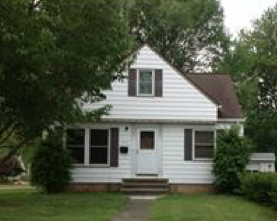This “Real” Investment Provides $9,240 of Income

From time-to-time, I like to share real investments and their actual returns. I find this to be helpful because many investing examples are hypothetical and it is hard to “see” actual results. So in this article, I’m going to share an actual investment one of my clients recently made and the actual numbers. Hopefully, this actual investment will be educational for those considering real estate as an investment.
Eight weeks ago, one of my clients purchased this home in Willowick for $64,000:
This home offered 4 bedrooms, 2 bathrooms, basement, and a detached garage. This home was in great shape and only required interior painting. The home has a newer roof, newer windows, newer furnace, and a newer air conditioner. The monthly property taxes for this home are $202 and the monthly home owners insurance is around $48 per month.
I helped this client secure a new high-quality tenant with a a monthly rental rate of $1,020. The passive income this investor will collect each month after paying taxes and insurance is $770. This works out to $9,240 annually. The annual return on the their $64,000 investment is 14.4%.
Since this client paid cash for this home, there is no mortgage payment and this monthly passive income can used to offset their living expenses, or it can be reinvested into other income producing assets. In fact, this investor could setup triple compounding with this investment property.
Some believe real estate is a risky investment and I might agree depending on the circumstances. For this particular investment, I would go the other direction and suggest it IS a safe long-term investment. Here are the four reasons why this is a safe investment:
1. The investor paid cash for the property and has zero debt on the property. They’ll never have to worry about a mortgage payment, short sale, or a possible foreclosure at any point in the future.
2. The major improvement items in the home have already been updated including the roof, windows, furnace, and air conditioner. They probably won’t have any major expenses for this property in the next 5 years.
3. This investor purchased this home below value. Comparable homes in the area are selling in the $90,000 to $100,000 price range. If house prices drop in the area, they’ll be protected because they have acquired instant equity by buying below value.
4. If the home is damaged by a severe storm or fire, the investor can submit a claim on their insurance policy and have the insurance company repair or rebuild the home on their behalf.
Where else can you get a 14% return on your investment and have insurance in place to protect your $64,000 investment?
My suggestion to this client is to use this monthly passive income to acquire BP stock. BP stock has been beaten up over the last few years and the price is extremely attractive. As I write this, BP’s dividend yield is 6.40%. By reinvesting the $770 of monthly income from this home into BP stock, this investor would increase their annual return on investment to 20.8%. (14.4% of the return would come from the home and the 6.4% would come from the BP stock.)
The investor would now be collecting $9,240 of income from the home and another $591 of income from the dividends paid by BP. Their total annual income after the first your would be $9,831.
Oddly enough, this income would increase each year going forward if the investor elected to automatically reinvest the BP dividends into more shares of BP stock. This investor’s passive income is guaranteed to increase EVERY year as more and more shares of BP are acquired through income from the property and automatic dividend reinvestment.
Here’s how this might look…
After the first year of following this plan, the investor would own $9,831 of BP stock. In the second year, this investor would collect $629 in new BP dividends on the first years stock purchases. Plus, they would purchase an additional $9,240 of BP stock using the monthly income from the rental property. This $9,240 of BP stock would produce another $591 of BP dividends.
Starting in year three, this investor would now have $20,291 of BP stock. They would collect $1,298 in dividends during the third year from this stock. Plus, they would acquire another $9,240 of stock using the income from the property. This $9,240 of BP stock would add another $591 of BP dividends.
Starting in year four, this investor would now have $31,420 of BP stock. They would collect….
The investor’s passive income increases EVERY year because they are accumulating more and more shares of BP.
Guess what?
We haven’t even factored in dividend increases. What would happen if BP increased the annual dividend by 10% each year? This investor would accumulate even more shares of BP.
Crazy, isn’t it?
Couldn’t you do something similar? Imagine setting up a safe long-term investment that compounds into more and more shares of high dividend paying stock. What would your life look like in 10 to 20 years if you were to follow this plan yourself?
